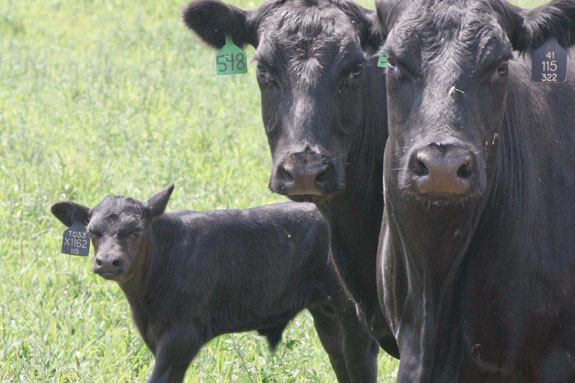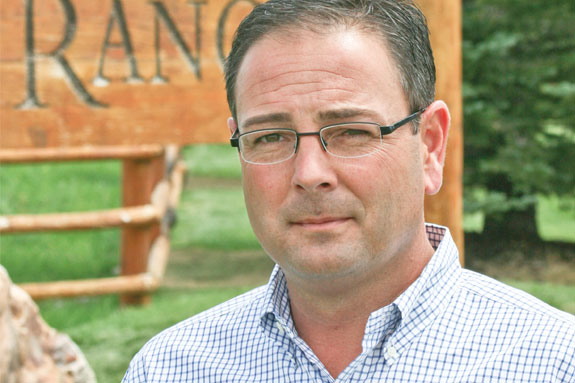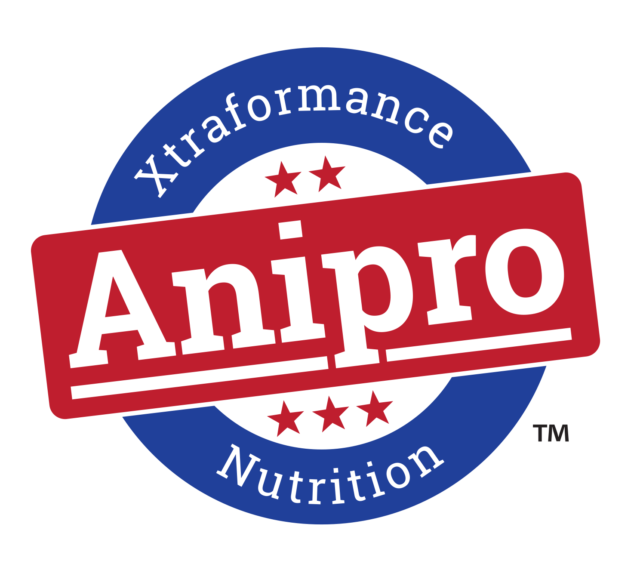Located at an elevation of 4,700 feet, and about an hour from the Grand Teton mountains, Riverbend Ranch of Idaho Falls, Idaho endures bone-chilling winters for a seedstock operation. Winter temperatures frequently dip into the negatives, with average daily lows hovering between 13 and 17 degrees Fahrenheit from December to February.
While an Oklahoma native like Brown can adjust to frozen winters, the task was even tougher for Riverbend’s prized seedstock cattle.
Since its start in 1991, the ranch owned by Frank and Belinda VanderSloot has expanded into one of the largest cow-calf and seedstock operations in the country.
With a commercial herd of approximately 7,500 cattle – including 1,500 purebred Angus – at four locations in Utah, Idaho, Montana and Texas, the calving process has been a defining element to the operation’s success. More than 1,700 purebred calves were born in 2009, many in the rigors of sub-zero temperatures around January and February.

But Brown recognized the stress of calving in the first two months of the year was inflicting a high price.
“With January calvers, we go out there in February and look at them and the cattle are fighting to keep themselves alive and their calves alive.”
That realization led to an innovative change at the ranch – a four-year transition wherein the majority of purebred calves would go from being born in January or February to late August.
“You look at a young cow calving in January and just the feed cost,” Brown says. “To take that cow from January, when she has that baby – just to maintain the body condition on that female where she is ready to breed back in April and where she can do an adequate job with that calf – the feed costs are staggering.”
The heavy winters were also harsh on the Riverbend crew. Using calving lots in confined areas, Riverbend employees routinely kept watch in 12-hour shifts in freezing temperatures. Once a calf was born, nursed and warmed, it returned with the mother back to the unforgiving elements. The environmental stress made calves susceptible to pneumonia and hypothermia.
As a result, Brown says the “rolling mortality average” in those months was 8 percent, but could go as high as 10 percent.
“But I have a real problem giving away 8 to 10 percent of my calf crop,” Brown said.

Changing the game
Riverbend’s March bull sale is a major event for cow-calf producers in the mountain West, a tradition Brown and his crew didn’t want to alter. Nor did the crew want to sell bulls younger than 13 or 14 months of age.
Jason Ahola, assistant professor at Colorado State University’s Department of Animal Sciences, says a calving transition is difficult for seedstock operations because of the buyers’ expectations.
“It’s one thing for a commercial cow-calf to do it, but when a seedstock operation does that, their historical bull buyers don’t like it,” Ahola said. “They like coming to buy bulls at a certain age.”
But Brown and his crew said it was the maturity of bulls that appealed to buyers, opening an opportunity to sell slightly older bulls, while delivering healthier calves. The ranch routinely saw more success with healthy calves born in March and April with its commercial herds.

The crew began observing what changes might work. Initially, some fall calvers had success with easier calving in September and October, but breeding them back in winter months proved to be tough.
Eventually a small portion of the herd calved in July and August, and the success rates were promising.
“What we saw was our calving rates were fantastic,” Brown says. “We didn’t lose many calves at all. We saw that the breed-back was astounding when we went in and bred those cattle in October and November. And so that made a lot of sense to us.”
After much discussion and planning, the ranch decided to organize a large shift so that the majority of the purebred herd would go to summer calving.
“The biggest hurdle for us in making that move was that we worked so hard to build enough quantity to satisfy our customers in terms of bulls,” says Brown about the ranch’s inventory. “We had gotten in the routine of offering 300 to 350 bulls a year.”
Riverbend opted to start leaving some cows open for about six months, then breed them in early fall. Since the ranch uses an embryo transfer program, production was increased in spring with the other two-thirds of the herd, to offset the loss of numbers.
It represented the start of a four-year effort. In the first year, 2009, the ranch had 300 of its 1,500 purebred cows shift to late-summer calving. Then in 2010, 300 more cows made the shift, and this year another 300 will go to summer. The transition will start slowing down in 2012, Brown says. The 500 winter calves for 2012 will be exclusively embryo transfers. “Eventually that winter calving number will go to zero.”

Seeing the results
Now starting its third year of the transition effort, the project is paying off in the key categories Riverbend targeted.
Brown believes the late-summer calvers can be carried on feed for about 33 percent less in costs than traditional January or February calving periods.
“The two highest times of the year for nutrition requirements are the first trimester and lactation, and if you can put those at any time of the year other than winter, that’s huge cost savings,” says Ahola.
In terms of labor, the ranch saw a 25 percent drop in the number of hours required to watch the purebred cows. The ease on the cows created ease on the ranch hands. Now, instead of braving 12-hour watch shifts in freezing temperatures, workers check the calving cattle once a day on the open pasture. Only one man is needed to check, tag and weigh newborn calves.
The morbidity rate, Brown estimated, will drop from around 8 to 10 percent in winter to between 4 and 6 percent.
The ranch’s calculations also show a 4 percent increase in the calf crop weaned per cows exposed. Brown says the ranch’s pregnancy rate is fairly constant, but fertility has also improved with the change, considering that a 10 percent jump was seen in the first service of artificial insemination in fall as opposed to spring.
“I think that’s directly correlated to the body condition of the cow,” Brown says. “The cow is going to be coming out of summer into fall with a baby at her side.”
A calving season shift like Riverbend’s can be beneficial to an entire cow herd, Ahola says, by boosting body condition scores and giving the cows a longer postpartum interval. Nutritionally the cow is healthier, and with 150 days of recovery before the next pregnancy, “the cows should be ultra-fertile and you should get them pregnant,” he says.
The biggest success is with the bottom line, Brown adds. Riverbend is seeing a 15 percent increase in the number of bulls that qualify for the bull sale. “That is a huge number,” Brown says. “When we calve exclusively in January or February, 55 percent of our bull calf crop would actually qualify for bull sale and sell at 14 months of age. With the late-summer calving scenario, we actually raised that number to 70 percent of our bull calf crop. I think it’s important to say that those bulls are actually selling at 19 to 20 months of age now.”
Based on customer response, Riverbend officials think the sale of more mature bulls only enhances the genetic quality and marketing appeal of the ranch’s seedstock crop. Brown has received more rounds of calls from cow-calf producers inquiring about the 18-month-old bulls.
“These guys run out in big country. These bulls have to cover a lot of acres. An older bull can cover more cows than a younger bull and the bulls will be more durable.
“There are very few bulls available out there that are 18 to 24 months of age. They are just happy to find someone out there producing them.”
Other changes
With the August calf crop, the winter would play an additional factor in weaning those same animals. So the ranch began weaning the late-summer calves even earlier in the year, around late January. “What we are trying to do there was get the calves off the cow before the most harsh period of winter hit us,” Brown explains.
Preparing bulls for sale was also revised, so that instead of a 30-day acclimation period for bull calves, Riverbend went to a 90-day period. But the feed performance test remained at 100 days for August calves, just as it had for January-February calves.
Brown and others worried that summer-born calves could be hit with more illnesses through the winter months, but the ranch actually saw less pneumonia and respiratory outbreak. September weather can change instantly in eastern Idaho, and there’s no dust in January or February to aggravate the stress of weaning. So the mortality rate during the weaning process also dropped.
But at Riverbend, they don’t need too many statistics to see the difference in the cattle.
“When these cows have one-month-old calves on them, you can tangibly see a difference in the stress levels of these cattle,” Brown said.
“And guess what, I see a lot less stress in our employees here.” ![]()
PHOTO 1:Visitors to the Riverbend Ranch study and make bids at the operation’s female sale held in October. The bull sale in March has grown more popular with the sale of older bulls.
PHOTO 2: Riverbend Ranch workers say they tangibly see a positive difference in the stress levels of their cattle since shifting calving seasons.
PHOTO 3:The surroundings for Riverbend Ranch in Idaho Falls, Idaho are as scenic as any in the country – but brutal cold is common in winter months.
PHOTO 4:As general manager of Riverbend Ranch, David Brown has changed how the seedstock producer calves purebreds to warmer seasons.
PHOTO 5:Riverbend calves born in late August like these purebred Angus have notably easier adaptation periods than was previously seen in January.







